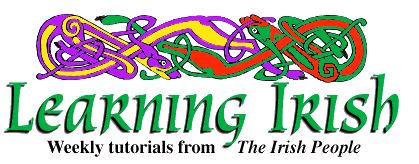
Irish Lesson 43
|
The numbering system in Irish differentiates among simple cardinals (either stand-alone numbers, such as occur in mathematics, or numbers giving the quantity of some object) and ordinals, which put objects in some order. This will become clear when you study this lesson. Counting These numbers are used in counting, telling time, and when the noun to which they refer goes before them.
Examples of use:
Giving quantities of some object, with the number preceding the noun:
aon bhó amháin, one cow dhá bhó, two cows trí bhó ceithre bhó cúig bhó sé bhó seacht mbó ocht mbó naoi mbó deich mbó aon bhó dhéag dhá bhó dhéag trí bhó dhéag ceithre bhó dhéag cúig bhó dhéag sé bhó dhéag seacht mbó dhéag ocht mbó dhéag naoi mbó dhéag fiche bó
In this use, as you can see, aon, one, aspirates, "two" becomes "dhá" and aspirates, "four" has changed slightly, and from 11 on, there is a "dheag", similar to English "teen", added on. From 1 to 6, the number causes aspiration (where possible), and from 7 to 10, the number eclipses (where possible). It all sounds complicated, but if you will practice on the lists above, and then try to use the numbers several times a day, say in counting or in reading license plates, one numeral at a time, you will be pleasantly surprised at your facility.
Now for a simpler and often-used help: telling time.
What time is it? Cén t-am é? a good morning, maidin mhaith good night, oíche mhaith mid-day, meán lae mid-night, meán oíche in the morning, ar maidin in the afternoon, tráthnóna at night, san oíche
Days of the week
Monday, An Luan
Tuesday, An Mháirt
Wednesday, An Chéadaoin
Thursday, An Déardaoin
Friday, An Aoine
Saturday, An Satharn
Sunday, An Domhnach (DOW-nahk*)
(c) 1998 The Irish People. May be reprinted with credit. |